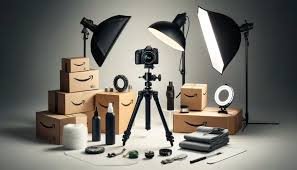If you’re selling on Amazon, great product photography is your ticket to standing out in the crowded marketplace. Your product images are often the first interaction customers have with your brand, so they need to captivate, inform, and persuade. This guide will walk you through everything you need to know about Amazon product photography, from understanding Amazon’s image requirements to advanced tips for making your products pop.
Why Amazon Product Photography Matters
Amazon is a visual marketplace. When a potential customer scrolls through search results, they don’t see detailed descriptions or customer reviews right away — they see images. High-quality images:
- Build Trust: Customers are more likely to trust a professional-looking product photo.
- Drive Clicks: Attractive images grab attention and improve click-through rates.
- Boost Conversions: Clear, high-quality photos help customers visualize the product, leading to higher conversions.
Investing in professional product photography is one of the smartest moves you can make to elevate your brand on Amazon.
Amazon’s Product Image Requirements
Before diving into creative strategies, you must adhere to Amazon’s strict image guidelines. Failing to meet these standards can result in your listing being suppressed. Here are the essentials:
- Primary Image:
- The main image must have a pure white background (RGB 255, 255, 255).
- The product should fill at least 85% of the frame.
- No text, logos, or additional graphics are allowed.
- Additional Images:
- These can include infographics, lifestyle shots, or zoomed-in details.
- They must be high-resolution (at least 1,000 pixels on the longest side).
- Technical Specifications:
- File format: JPEG, PNG, GIF, or TIFF.
- Color mode: RGB or CMYK.
Types of Amazon Product Photos
To fully utilize the available image slots on Amazon, consider incorporating the following photo types:
1. Main Product Image
The primary image is the showstopper. It should feature your product against a clean, white background with no distractions. Invest in professional lighting and a high-resolution camera to make the product appear crisp and appealing.
2. Lifestyle Images
These photos show the product in action, helping customers visualize how they’ll use it. For example, a blender can be photographed in a kitchen setting with fruits and vegetables around it.
3. Infographic Images
Infographics highlight key product features and specifications. Use text overlays and graphics to explain dimensions, materials, or unique selling points.
4. Close-Up Shots
Zoom in to showcase textures, materials, or intricate details. This is particularly important for fashion items, electronics, and handmade goods.
5. Comparative Images
If size matters for your product, use images to compare it with everyday objects (e.g., showing a backpack alongside a water bottle).
Tools and Equipment for High-Quality Photography
1. Camera
You don’t need the most expensive camera, but a DSLR or mirrorless camera with high resolution is a must. Popular options include the Canon EOS Rebel series or Sony Alpha cameras.
2. Lighting
Good lighting is crucial. Natural light works well, but softbox lights and ring lights provide consistent results.
3. Tripod
A tripod ensures stability and prevents blurry photos. Adjustable tripods with ball heads are ideal for capturing various angles.
4. Editing Software
Post-production is as important as the photoshoot itself. Adobe Photoshop and Lightroom are excellent tools for retouching and enhancing images.
DIY Photography vs. Hiring Professionals
If you’re on a tight budget, DIY photography is a viable option. However, for sellers looking to scale or position their brand as premium, hiring a professional can be a game-changer.
Professional photographers not only have advanced equipment but also understand the nuances of lighting, composition, and retouching. Agencies like Swiftstart specialize in Amazon design and creative services, helping you craft stunning product imagery that aligns with your brand’s vision.
Advanced Tips for Amazon Product Photography
1. Show Context
For products that may seem ambiguous in size or functionality, show them in context. For instance, a desk organizer can be photographed on a desk with stationery to provide scale and usability context.
2. Use 360-Degree Photography
Allow customers to view your product from every angle. This immersive experience builds trust and reduces uncertainty, especially for high-ticket items.
3. Focus on the Hero Shot
The first image a customer sees (your main photo) should be your hero shot — clean, attention-grabbing, and perfectly executed.
4. A/B Testing
Don’t assume your images are perfect. Conduct A/B tests to see which photos perform better in terms of click-through and conversion rates.
Common Mistakes to Avoid
- Overcrowded Frames: Keep the focus on your product. Avoid cluttered backgrounds or unnecessary props.
- Ignoring Amazon Guidelines: Ensure every photo meets Amazon’s technical and stylistic requirements.
- Poor Editing: Over-editing can make your product look unnatural. Aim for clear, authentic imagery.
Partnering with Experts
If the thought of managing Amazon product photography feels overwhelming, you’re not alone. Many sellers turn to professional agencies like Swiftstart for help. As an Amazon creative agency, Swiftstart specializes in crafting visually stunning product images that not only comply with Amazon’s guidelines but also enhance your brand identity.
Whether you’re looking for lifestyle photography, infographics, or A+ content design, Swiftstart’s team can handle it all, ensuring your product listings stand out in the competitive Amazon marketplace.
Conclusion
Great Amazon product photography is more than just clicking a button. It’s about storytelling, building trust, and creating a visual experience that compels customers to click “Add to Cart.” By understanding Amazon’s guidelines, investing in the right tools, and leveraging professional expertise, you can elevate your product listings to new heights.
Start your journey today by ensuring your images reflect the quality and value of your products. If you’re ready to go the extra mile, consider partnering with an Amazon design agency like Swiftstart to maximize your brand’s potential.














Leave a Reply